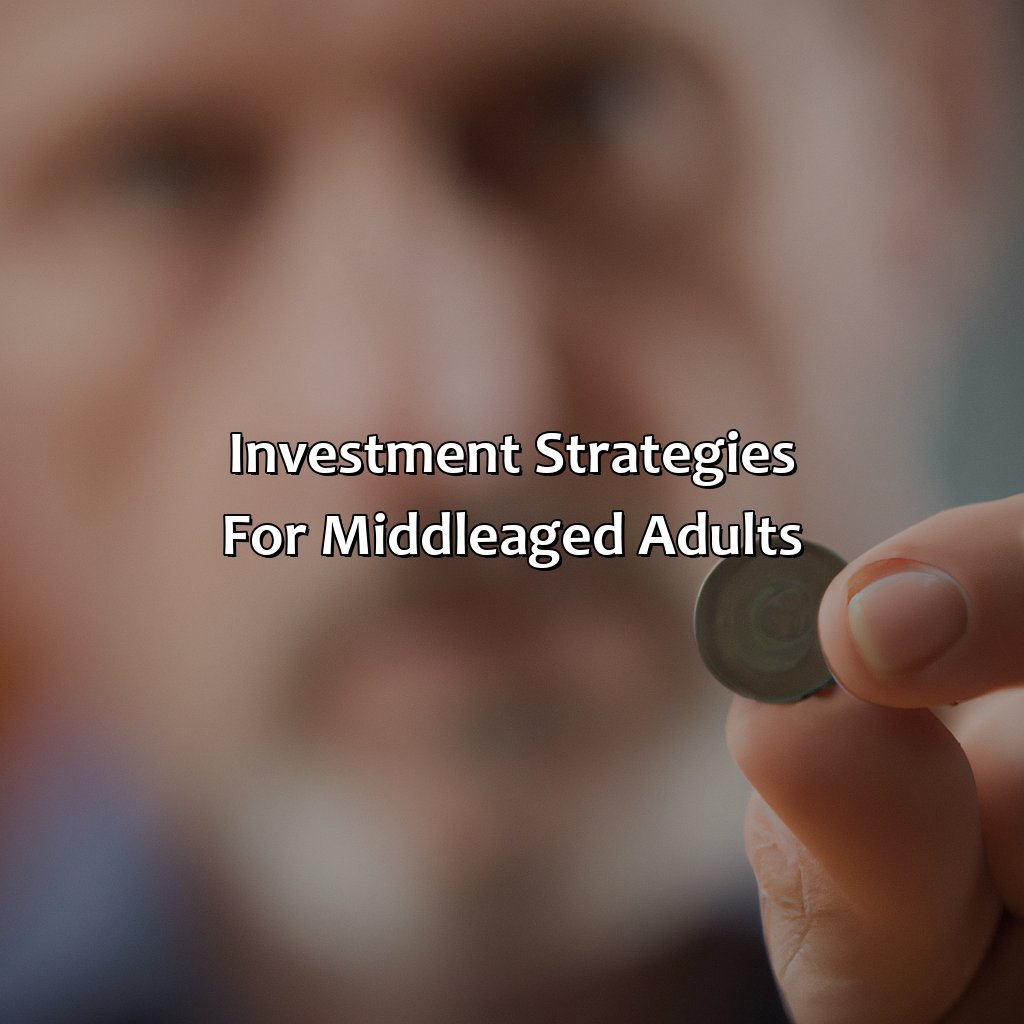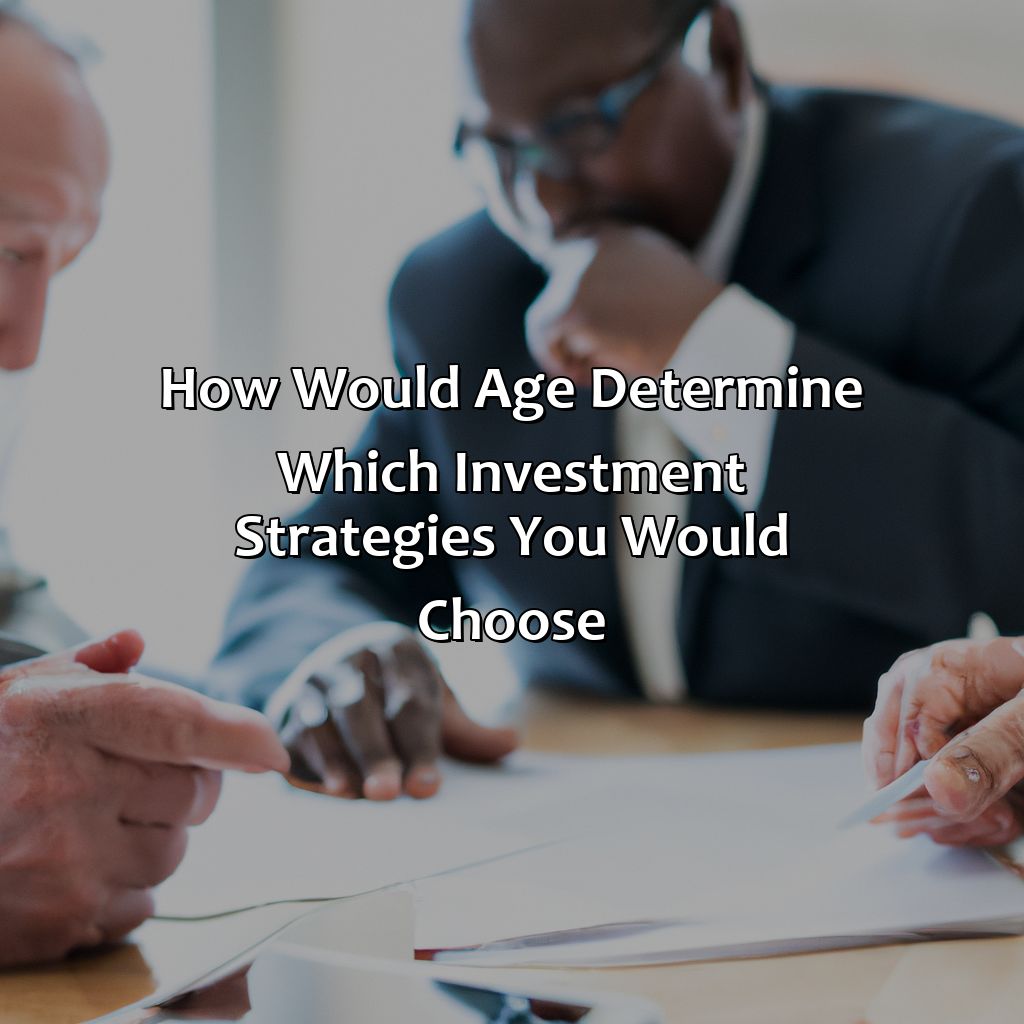How Would Age Determine Which Investment Strategies You Would Choose?
Key Takeaway:
- For young adults, long-term goals should be the predominant factor in their investment strategy. Diversification is important, as well as taking calculated risks with high-reward investments. Tax-efficient investments can also be a smart choice for those just starting out.
- As middle-aged adults approach closer to retirement, balancing risk and reward becomes more important. Planning for retirement and focusing on income-producing investments can help provide a more stable financial future.
- For older adults, preserving their wealth and minimizing risk is crucial. Moving towards income-generating assets, such as bonds or dividend-paying stocks, can provide a steady income stream. Estate planning and succession should also be a consideration.
Have you ever wondered how age impacts your investment strategies? You may be surprised to learn that the age you are can make a huge difference in the type of investments you select. Read this article to discover the best investment strategies for your age!
Investment strategies for young adults
As a young adult, it is essential to think about your long-term goals when choosing the right investment strategies. Consider diversifying your portfolio. High-risk/high-reward investments and tax-efficient investments are also options. This section will explain why long-term goals are key. Plus, what investment options you should explore.

Image credits: retiregenz.com by David Woodhock
Importance of long-term goals
Investing with a futuristic perspective is crucial, especially for younger adults who have time on their side. In this regard, the significance of establishing long-term goals cannot be overstated. This ensures that investments are made in accordance with one’s objectives and enables monitoring of progress towards these milestones. A well-defined goal can help guide investment decisions, creating a clear sense of direction and purpose.
One must choose an investment strategy based on their age and associated level of risk tolerance to achieve long-term financial objectives. For instance, young adults with ample time can afford a more aggressive approach, deploying a greater portion of savings towards riskier asset classes like equities or property. On the other hand, older investors would likely adopt a less risky approach and maintain lower exposure to unpredictable assets.
It is worth noting that while investing for the long term comes with potential rewards, it also involves its own set of risks. Creating multiple portfolios geared towards different stages in life can help mitigate losses incurred amidst market downturns while striving to maximize returns.
For example, Warren Buffet’s timeless technique holds relevance even today as he advocates holding onto your investments for as long as possible and diversifying your portfolio based on how much surplus wealth one has at their disposal.
As such investing in the stock markets with guidance from financial advisors can pay dividends down the line when combined with a properly crafted roadmap taking into account one’s personal situation and long term goals.
Mix it up like a bartender – a diversified portfolio is the perfect blend of stocks, bonds, and a splash of risky investments.
Diversified portfolio
A varied range of investments that a young adult chooses is known as a mixed portfolio. It helps to minimize risk and maximize returns by allocating money across different asset classes like stocks, bonds, real estate, and commodities. By employing this strategy, one can reduce the vulnerability to market volatility and ensure long-term financial security.
Focusing exclusively on low-risk investment options like savings accounts or fixed deposits may not be suitable for young adults due to the limited growth potential. Instead, spreading your money over various instruments can minimize investment risks while also generating more significant returns in the long term. A diversified portfolio can provide individuals with stable cash flows and help fulfill their financial goals.
A common misconception about diversification is that it requires substantial amounts of capital or professional knowledge. However, even small amounts of savings regularly directed towards different asset classes can help start creating a diverse range of investments over time.
Pro Tip: Creating a balanced portfolio depends on individual preferences, risk appetite, and financial goals; therefore, seeking professional advice is recommended before making any investment decisions.
Trying to make a quick buck through high-risk investments is like trying to win a marathon by sprinting the first 100 meters.
High-risk, high-reward investments
Investment Options with High Potential Gains and Losses
High-risk, high-reward investments involve the potential for substantial gains and losses. These types of investments can be attractive to young adults who have a longer investment horizon. However, they should also be aware that investing in these options can result in significant financial losses.
- One example of a high-risk investment is investing in individual stocks. This strategy has the potential to yield impressive returns, but there’s also the possibility that an investor may lose most or all of their money if the stock doesn’t perform well.
- Cryptocurrency is another popular option for high-risk investors as prices can fluctuate dramatically based on market demand and supply. While they can potentially offer massive returns, there is also a possibility of huge losses here.
- Venture capital investments in startups have become the talk of the town. Although they provide great growth opportunities for young investors, it comes at an extremely high risk because startups typically lack an established financial record.
It is vital to note that, Investors must consider their risk tolerance before making any investment decision as every individual is unique hence will have a different outlook towards certain investment scenarios.
Pro Tip: In general, diversification across multiple asset classes lessens exposure to volatility in one area and enhances long-term returns.
Saving money on taxes is great, but it’s not worth going to jail over – stick to legal tax-efficient investments.
Tax-efficient investments
Optimizing investment returns through tax savings is an excellent strategy for progressive growth. By adopting a tax-efficient investment plan, you can enhance your profits without increasing the risk factor. One of the best ways to optimize your returns is by investing in Tax-Free Savings Accounts (TFSAs) and Registered Retirement Savings Plans (RRSPs). TFSAs offer tax-free accumulation of earnings, while RRSP contributions bring down your taxable income.
It’s imperative to assess your age and investment goals before choosing an appropriate strategy. Young investors with a longer time horizon may prefer equity-based investments such as stocks and mutual funds that have higher risk but yield high returns in the long run. Besides, investing in asset classes that give tax deductions such as education expenses or charitable donations could also divest taxes.
Interestingly, innovative solutions like Socially Responsible Investing (SRI) enable investors to enjoy tax benefits while contributing towards societal betterment.
Pro Tip: Instead of placing all eggs in one basket, diversify your portfolio across different asset classes and industry sectors for better stability.
Investing in cryptocurrency may make you feel young again, but for middle-aged adults, sticking to traditional investment strategies may be wiser.
Investment strategies for middle-aged adults
It’s essential to make knowledgeable investment decisions in middle age. To do this, balance risk and reward, plan for retirement, and focus on earning investments. This section on “Investment strategies for middle-aged adults” with sub-sections of “Balancing risk and reward”, “Retirement planning”, and “Focus on income-producing investments” will give you the understanding you need to make a successful investment plan to meet your financial objectives at midlife.

Image credits: retiregenz.com by Harry Duncun
Balancing risk and reward
Maintaining Equilibrium between Uncertainty and Potential Returns
Choosing the appropriate investment strategy can be daunting for middle-aged adults. With a wide variety of options, it is crucial to find a balance between risk and reward. To achieve this, individuals must evaluate their comfort level with uncertainty while keeping in mind their financial goals and future needs. It is essential to diversify investments across asset classes while allotting funds according to age and risk tolerance.
Investment portfolios should consider the investor’s age and future financial objectives as well. For instance, middle-aged adults should allocate a reasonable portion of their funds towards equity investments that offer high potential returns, even though it entails taking on more financial risks. This strategy could be an ideal option for those who have plenty of time ahead before they hit retirement age.
Additionally, regular performance reviews of investment selections may help identify adjustments as per market trends and personal goals.
As the strategies, market trends change so do investment decisions by individuals. While some people might opt for high-risk-high reward investments given their occupation or experience in dealing with money management, there are those who might prefer conservative strategies due to several reasons ranging from having dependents relying on them or safety needs etc.
A friend of my father’s actively managed his investments over the years and earlier this year had heaps of dividend-paying stocks that would pay handsomely during times when interest rates are low. He was able to retire early and live off the dividends he earned from those stocks, making him financially secure far beyond his retirement years.
Why wait till retirement to live like a retiree? Start investing wisely now and enjoy those early bird specials with a peace of mind.
Retirement planning
As we mature, our retirement planning becomes increasingly vital. Our investment strategy and risk tolerance often depend on our age. As we plan for retirement, understanding one’s financial priorities and time frame can help you determine the most appropriate investments to make.
As middle-aged adults approach retirement, their financial situation can become more complex. They may have accumulated significant debt due to a mortgage or paying for their children’s college education. However, they may also have begun saving seriously towards a financially secure future. As such, investment strategies for this group must balance the need to pay off debts against the importance of building wealth.
When assessing investment options in middle age, it is essential to consider not only current financial needs but also long-term financial goals such as retirement income and estate planning. A balanced portfolio of stocks and bonds helps manage risk over time while providing steady growth opportunities.
It was not long ago when retirees could live comfortably on yields from bonds and pensions alone. Today’s retirees experience increased longevity with uncertain interest rates and stock market volatility. Investment strategies that provided security in previous generations often no longer cut it when presented with today’s economic realities.
If you want to secure your future, focus on income-producing investments instead of buying a yacht that will only leave you with empty pockets and a lot of saltwater.
Focus on income-producing investments
Investment strategies play a crucial role in securing the financial future of middle-aged adults. Opting for income-producing investments is one such strategy that can offer security and stability. Investors focusing on cash-generating assets like dividend-paying stocks, rental properties or bond funds, can ensure that a steady stream of income is received regularly.
Choosing income-producing investments can offer many long-term benefits to investors. Not only do they provide consistent incomes but can also help to build wealth over time. Income investments tend to be less volatile than growth-type assets making them less risky options for middle-aged adults. This way, investors can secure their finances and work towards their retirement goals.
Moreover, it is essential to diversify one’s investment portfolio across industries and sectors for greater stability. Investing in different types of income-generating securities like bonds or real estate investment trusts (REITs) provides broader exposure to the market resulting in reduced risk while increasing the potential for long-term returns.
For instance, during the 2008 financial crisis, investors who had invested heavily in property markets faced significant losses, highlighting the importance of careful allocation of funds across different asset classes. Therefore, investing for income rather than capital gains should always remain a top priority for middle-aged adults looking towards financial security by reducing risk and generating stable cashflows through their portfolios.
You’re never too old to invest, but maybe it’s time to switch from high-risk stocks to high-fiber diets.
Investment strategies for older adults
As an older adult, planning for the future financially is key. To maximize wealth and reduce risk, look into preserving it and investing in assets that generate income. Additionally, planning your estate and succession will ensure your assets are distributed like you wish.

Image credits: retiregenz.com by James Duncun
Preserving wealth and minimizing risk
A critical aspect of investment strategy is to protect financial assets while withholding risks. The quest for wealth preservation brings older adults to choose investment strategies that will help them achieve this goal. Older adults tend to choose safer investment options such as fixed-income securities, government bonds, and CDs instead of high-risk investments like stocks or mutual funds. By minimizing risks, they seek to garner a steady stream of returns and safeguard their accumulated wealth.
While choosing the best-suited investment strategy, older adults primarily consider their age as an essential determinant factor. Depending on which segment they belong to – pre-retirement or post-retirement- would play a crucial role in shaping the type of investments they settle for.
As older adults often worry about outliving their savings, preserving wealth becomes paramount. It might compel them to opt for low-yielding but stable investments with minimal risk. Alternatively, some may choose to invest in diverse portfolios consisting of mixed assets like bonds, equities, etc., that would give higher returns in the long run.
Investing always requires discernment – more so when it involves life savings during one’s twilight years. Therefore it is essential that older adults consult professionals well-versed with market trends while taking decisions concerning their investments.
Choosing the right investment plan can help secure financial stability and mitigate unforeseen circumstances like illness or emergencies. Ignoring this vital step may cause potential losses of both principal sums and dividend earnings and disrupt one’s economic equilibrium leading to fear of missing out on desirable retirement goals.
Retirees, it’s time to turn those assets into asset$ – investing in income-generating assets is the ultimate retirement hack.
Moving towards income-generating assets
As individuals age, they tend to move towards income-generating assets for financial stability. This shift is due to the need for a reliable source of income during retirement. Income-generating assets, such as bonds and dividend-paying stocks, provide regular payments.
Moreover, these assets offer protection against inflation and market volatility. They are less risky than growth-oriented investments such as stocks and mutual funds, which have more exposure to market fluctuations.
To further strengthen the investment portfolio of older adults, it is advisable to diversify their income-generating assets. For instance, investing in real estate properties that generate rental income can be an excellent addition to the portfolio.
By diversifying the portfolio with different types of income-generating assets, individuals can reduce the risk of relying solely on one type of asset and increase their chances of achieving consistent returns. With proper planning and guidance from a financial advisor or planner, older adults can enjoy stable retirement incomes while securing their future financial needs.
Planning your estate is like playing chess, but with higher stakes and no chance of a rematch.
Estate planning and succession
Planning for the transfer of wealth and assets to heirs and beneficiaries is an essential aspect of financial planning. Creating a comprehensive plan to distribute one’s estate and legacy in a tax-efficient manner is known as succession planning. For older adults, it is crucial to ensure that their assets are protected and transferred according to their wishes after they pass away.
To begin with, successful estate planning requires careful consideration of one’s net worth, liquidity needs, family situation, and tax implications. Setting up trusts, creating a will or revocable trust, making gifts during one’s lifetime, and using life insurance policies are all effective strategies that can be employed while planning the transfer of assets from one generation to another.
Moreover, appointing trusted individuals like executors or trustees ensures that the estate plan is executed smoothly and efficiently. It’s also vital to keep the estate plan up-to-date by regularly reviewing it when significant life changes occur such as marriage or divorce.
Five Facts About How Age Determines Investment Strategies:
- ✅ Younger investors tend to take more risks and invest more aggressively in stocks and growth-oriented assets. (Source: Forbes)
- ✅ As investors approach retirement age, they tend to shift their investment portfolio towards safer assets such as bonds and dividend-paying stocks. (Source: Fidelity)
- ✅ Investors in their 30s and 40s should focus on building a diversified portfolio of assets and creating an emergency fund. (Source: Kiplinger)
- ✅ As investors age, their focus should shift from accumulating assets to preserving wealth and generating income. (Source: Investopedia)
- ✅ Asset allocation is key for investors of all ages, as a well-diversified portfolio can help mitigate risk and maximize returns. (Source: Charles Schwab)
FAQs about How Would Age Determine Which Investment Strategies You Would Choose?
How would age determine which investment strategies you would choose?
Age plays a crucial role in determining the investment strategies that you should adopt. Here are six frequently asked questions and answers on how age can affect your investment strategy decisions.
What investment strategies are most suitable for young investors?
Young investors typically have a long investment horizon and can afford to take more risks than older investors. As such, they may opt for more aggressive investment strategies such as investing in high-growth stocks, mutual funds, ETFs, and other high-risk investments.
What investment strategies are most suitable for middle-aged investors?
Middle-aged investors may have more financial responsibilities such as family, mortgages, and other expenses. They may opt for more balanced investment strategies, such as investing in a mix of stocks, bonds, and other low-risk investments to hedge against market volatility.
What investment strategies are most suitable for pre-retirees?
Pre-retirees typically have a shorter investment horizon than young or middle-aged investors. As such, they may opt for more conservative investment strategies, such as investing in blue-chip stocks, bonds, mutual funds, and other low-risk investments that offer predictable returns.
What investment strategies are most suitable for retirees?
Retirees need to focus on generating income from their investments, as they no longer have a regular source of income. They may opt for more income-generating investments such as bonds, fixed-income mutual funds, annuities, and dividend-paying stocks.
Can age affect your risk tolerance?
Yes, age can affect your risk tolerance. Generally, younger investors have a higher risk tolerance as they have more time to recoup any losses, while older investors may have lower risk tolerance as they have less time to recover from any losses.
What if I don’t know which investment strategy to choose based on my age?
If you’re not sure which investment strategy to choose based on your age, seek the advice of a financial advisor or investment professional. They can help you determine the best investment strategy based on your age, financial goals, and risk tolerance.


